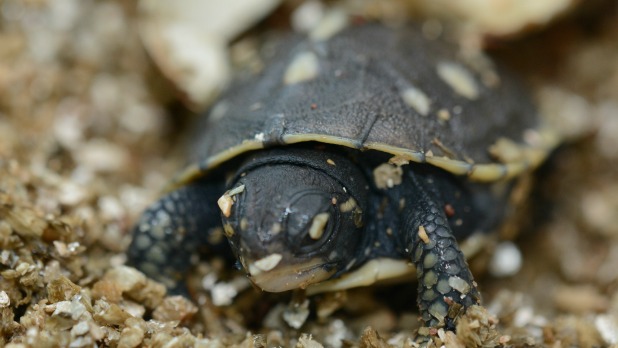Eastern box turtles have a new heroine on their side thanks to a passionate biology professor at Clayton State University as the species sees a dramatic decline.
For the past three years, Dr. Diane Day has made it her mission to help find a way to increase Eastern box turtle numbers, and she has been researching, tracking, and protecting the animals and their nests on a stretch of land in Fayetteville that’s managed by the Southern Conservation Trust (SCT). The SCT is a land trust founded in 1993 by residents in Fayette County in an effort to preserve greenspace as the community continues to grow.
“These turtles used to thrive from Maine all the way down to Florida, but now there are none in Maine, and you’ll likely only find them from Virginia to Florida,” said Dr. Day.
According to the professor, raccoons, coyotes, and non-native species like armadillos and fire ants aren’t the only reason the Eastern box turtle population is declining. Newly-constructed neighborhoods that are encroaching on their habitat and careless people are also to blame.
“I’ve seen people deliberately try to hit them with their cars. Please don’t do that. If it’s safe to stop the car and help them across the road in the direction the turtle is going, then please do that,” said Dr. Day.
“People also think these animals are cute and make great pets, but they need to know that these turtles are protected. You are not allowed to work with them or take them home unless you have a license from the Department of Natural Resources.”
Within the last few years, Dr. Day and the SCT have worked together to identify more than 750 turtles in this area — making it one of the largest Eastern box turtle projects in the state. One puzzling thing the professor has noticed recently is that some turtles are starting to show up with holes in the bottom of their shells.
“We’ve taken some of these turtles to a pathologist to determine if it’s some type of fungus or infection, but it’s still unclear what’s causing it. Some of these holes are so big that the turtles can’t protect themselves when they try to close themselves in their shells,” said Dr. Day.
During the course of her research and conservation efforts, the professor has entrusted students seeking research credit to help study the animals, and she recently saved several eggs from nests that were in an area designated for a new parking lot the SCT created at the nature preserve. It’s a move she says she’d like to turn into a program aimed at further protecting the animals.
“I want to start a Head Start program for hatchlings, and keep them for at least two years before returning them to the wild. By that age, they’ll be large enough to protect themselves from predators.”
To learn more about Eastern box turtles and conservation efforts, please visit http://aboxturtle.com/state_laws.htm.













Leave a Comment
You must be logged in to post a comment.